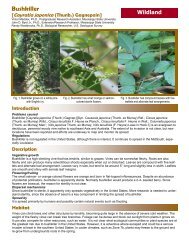RATopic1_95 - Geosystems Research Institute - Mississippi State ...
RATopic1_95 - Geosystems Research Institute - Mississippi State ...
RATopic1_95 - Geosystems Research Institute - Mississippi State ...
You also want an ePaper? Increase the reach of your titles
YUMPU automatically turns print PDFs into web optimized ePapers that Google loves.
Task 3.1. Early Detection and Reporting of Cactus Moth<br />
PI: Richard L. Brown<br />
Co-PI: John Madsen, Victor Maddox<br />
Collaborators: Randy Westbrooks, USGS NWRC; Joel Floyd, USDA APHIS PPQ; John C. Stewart, USDA APHIS<br />
PPQ, Thomas Simonsen, Natural History Museum, London; Sangmi Lee, MSU<br />
Establishment of Quarantine Facility for Rearing Cactus Moths<br />
Richard L. Brown<br />
<strong>Research</strong> on cactus moths, Cactoblastis cactorum, and their biology and interactions<br />
with host species of cactus required the establishment of quarantine<br />
facility for rearing this species at <strong>Mississippi</strong> <strong>State</strong> University. Space for this<br />
quarantine rearing center was obtained at the Insect Rearing Facility in the<br />
Department of Entomology and Plant Pathology at MSU, where three of the<br />
six environmentally controlled rooms were dedicated towards rearing cactus<br />
moths. In order to obtain a permit as a quarantine facility, a Standard Operation<br />
Procedure (SOP) was developed to address criteria required for ensuring<br />
the security of the containment area. The application for the permit with the<br />
SOP was followed by an on-site inspection by USDA-APHIS personnel to<br />
ensure that all criteria had been met.<br />
The rearing rooms have a unique keyed lock with keys made available for<br />
only the Directors of the facility, Drs. John Schneider and Frank Davis, the<br />
Containment Director and author of the SOP, Dr. Richard Brown, and Cactus<br />
Moth Rearing Officer, Dr. Travis Marisco. The Rearing Facility has two<br />
HVAC systems for a closed air system that flows through filters that occlude<br />
particles larger than 5 microns. The outside vent for fresh is covered with an Figure 1. One of three rearing rooms in<br />
8-mesh screen. The rearing rooms are controlled and monitored by a Johnson the Quarantine Facility with cages holding<br />
Control, Inc., direct digital control system running under a LON computer cactus moths used in research by Gary<br />
network protocol. All cactus moths are reared in cages on species of Opuntia Ervin and Travis Marsico.<br />
cactus native to <strong>Mississippi</strong>. All specimens are confined in cages to prevent<br />
escape (Figure 1). All materials used for rearing cactus moths are autoclaved before removal from the rearing facility.<br />
<strong>Research</strong> in the facility by Drs. Gary Ervin and Travis Marsico on the comparative fitness of Cactoblastis cactorum and<br />
Melitara prodenialis has provided secondary benefits in collaboration with Richard Brown. Two species of parasitoids<br />
of Melitara prodenialis, a tachinid fly (Acantholespia constocki) and an ichnemonid wasp (Telemucha sinuata) (Figure<br />
2), and the fungus Beauveria bassiana<br />
have been identified as causing mortality<br />
to Melitara prodenialis, but none of these<br />
were found to attack Cactoblastis cactorum.<br />
Figure 2. Telemucha sinuata (Ichneumonidae), a parasitoid reared from<br />
Melitara prodenialis.<br />
2009 USGS Annual Report 19 <strong>Mississippi</strong> <strong>State</strong> University’s <strong>Geosystems</strong> <strong>Research</strong> <strong>Institute</strong>




